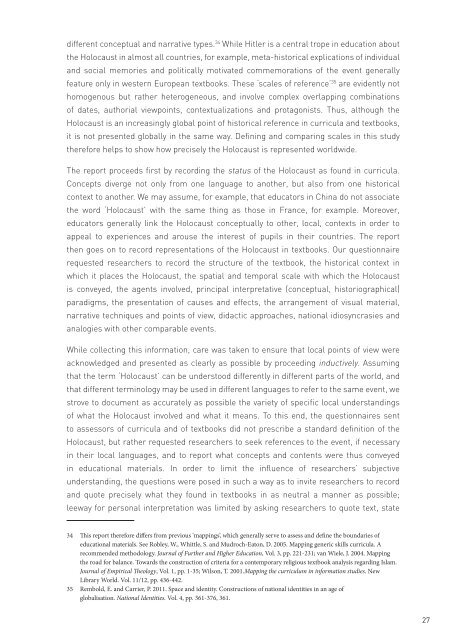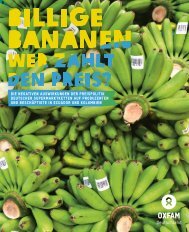228776e
228776e
228776e
You also want an ePaper? Increase the reach of your titles
YUMPU automatically turns print PDFs into web optimized ePapers that Google loves.
different conceptual and narrative types. 34 While Hitler is a central trope in education about<br />
the Holocaust in almost all countries, for example, meta-historical explications of individual<br />
and social memories and politically motivated commemorations of the event generally<br />
feature only in western European textbooks. These ‘scales of reference’ 35 are evidently not<br />
homogenous but rather heterogeneous, and involve complex overlapping combinations<br />
of dates, authorial viewpoints, contextualizations and protagonists. Thus, although the<br />
Holocaust is an increasingly global point of historical reference in curricula and textbooks,<br />
it is not presented globally in the same way. Defining and comparing scales in this study<br />
therefore helps to show how precisely the Holocaust is represented worldwide.<br />
The report proceeds first by recording the status of the Holocaust as found in curricula.<br />
Concepts diverge not only from one language to another, but also from one historical<br />
context to another. We may assume, for example, that educators in China do not associate<br />
the word ‘Holocaust’ with the same thing as those in France, for example. Moreover,<br />
educators generally link the Holocaust conceptually to other, local, contexts in order to<br />
appeal to experiences and arouse the interest of pupils in their countries. The report<br />
then goes on to record representations of the Holocaust in textbooks. Our questionnaire<br />
requested researchers to record the structure of the textbook, the historical context in<br />
which it places the Holocaust, the spatial and temporal scale with which the Holocaust<br />
is conveyed, the agents involved, principal interpretative (conceptual, historiographical)<br />
paradigms, the presentation of causes and effects, the arrangement of visual material,<br />
narrative techniques and points of view, didactic approaches, national idiosyncrasies and<br />
analogies with other comparable events.<br />
While collecting this information, care was taken to ensure that local points of view were<br />
acknowledged and presented as clearly as possible by proceeding inductively. Assuming<br />
that the term ‘Holocaust’ can be understood differently in different parts of the world, and<br />
that different terminology may be used in different languages to refer to the same event, we<br />
strove to document as accurately as possible the variety of specific local understandings<br />
of what the Holocaust involved and what it means. To this end, the questionnaires sent<br />
to assessors of curricula and of textbooks did not prescribe a standard definition of the<br />
Holocaust, but rather requested researchers to seek references to the event, if necessary<br />
in their local languages, and to report what concepts and contents were thus conveyed<br />
in educational materials. In order to limit the influence of researchers’ subjective<br />
understanding, the questions were posed in such a way as to invite researchers to record<br />
and quote precisely what they found in textbooks in as neutral a manner as possible;<br />
leeway for personal interpretation was limited by asking researchers to quote text, state<br />
34 This report therefore differs from previous ‘mappings’, which generally serve to assess and define the boundaries of<br />
educational materials. See Robley, W., Whittle, S. and Mudroch-Eaton, D. 2005. Mapping generic skills curricula. A<br />
recommended methodology. Journal of Further and Higher Education, Vol. 3, pp. 221-231; van Wiele, J. 2004. Mapping<br />
the road for balance. Towards the construction of criteria for a contemporary religious textbook analysis regarding Islam.<br />
Journal of Empirical Theology, Vol. 1, pp. 1-35; Wilson, T. 2001.Mapping the curriculum in information studies. New<br />
Library World. Vol. 11/12, pp. 436-442.<br />
35 Rembold, E. and Carrier, P. 2011. Space and identity. Constructions of national identities in an age of<br />
globalisation. National Identities. Vol. 4, pp. 361-376, 361.<br />
27




